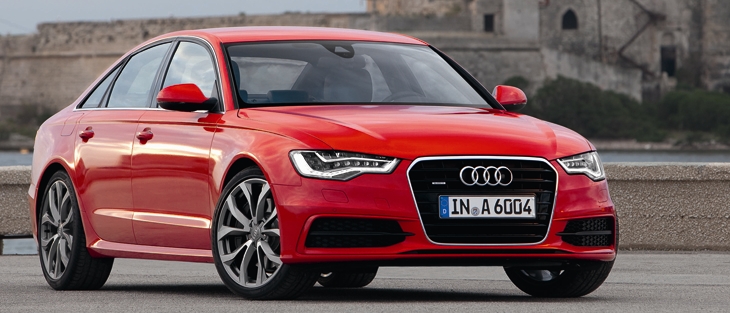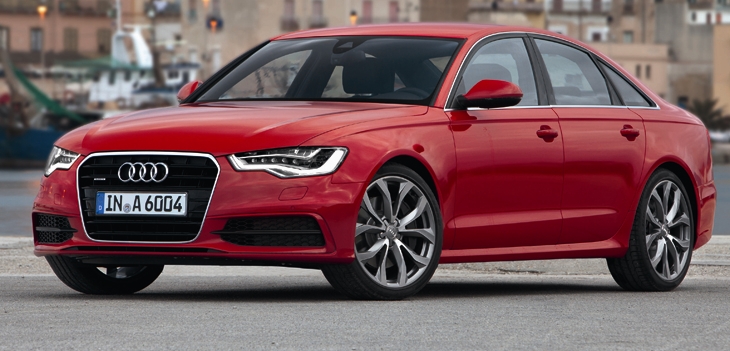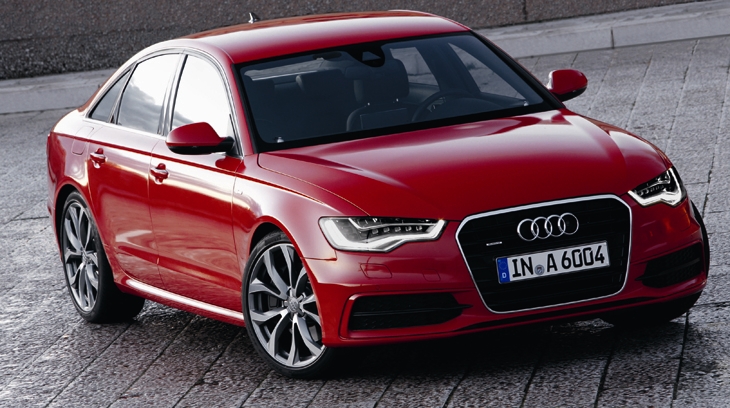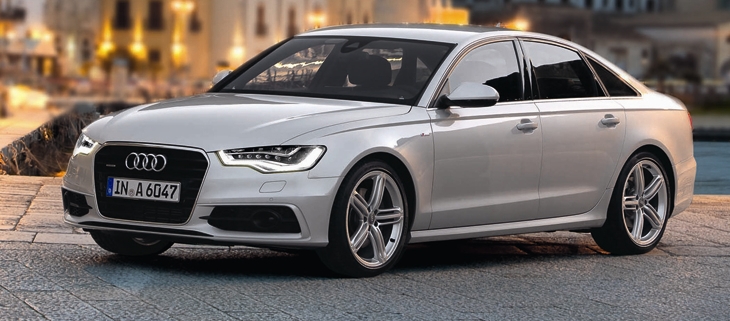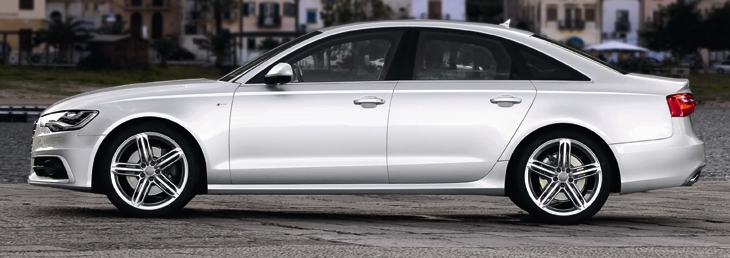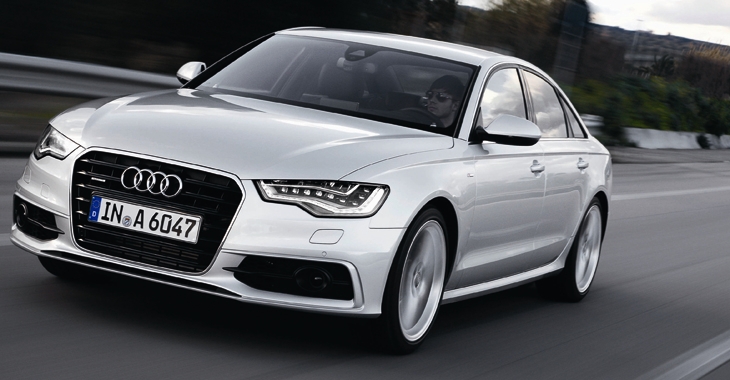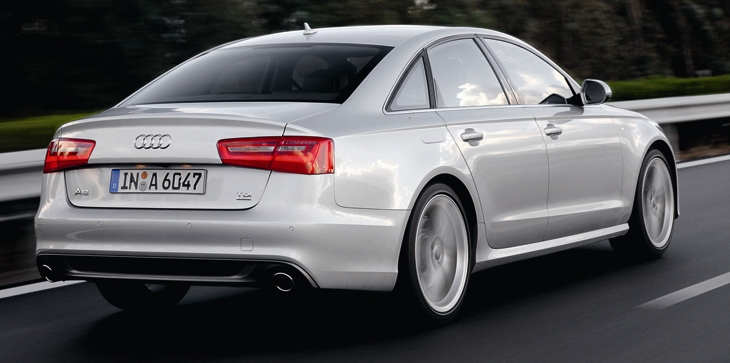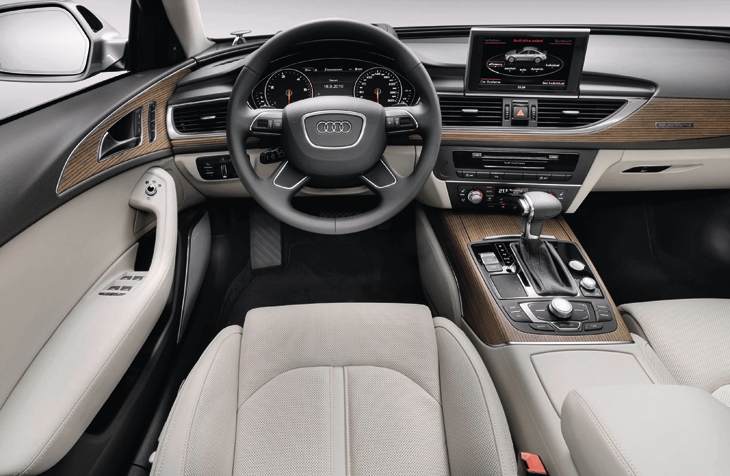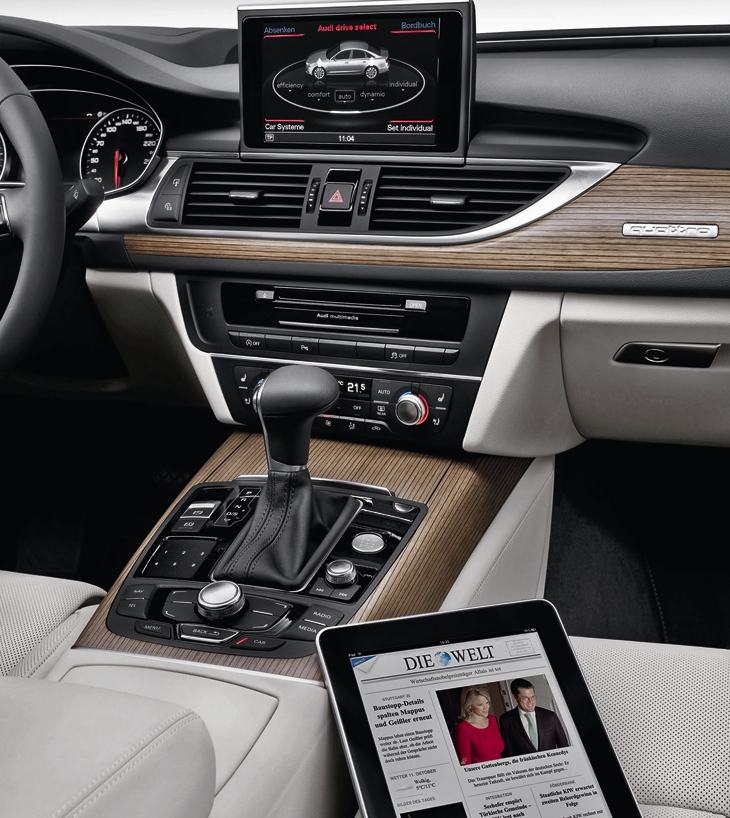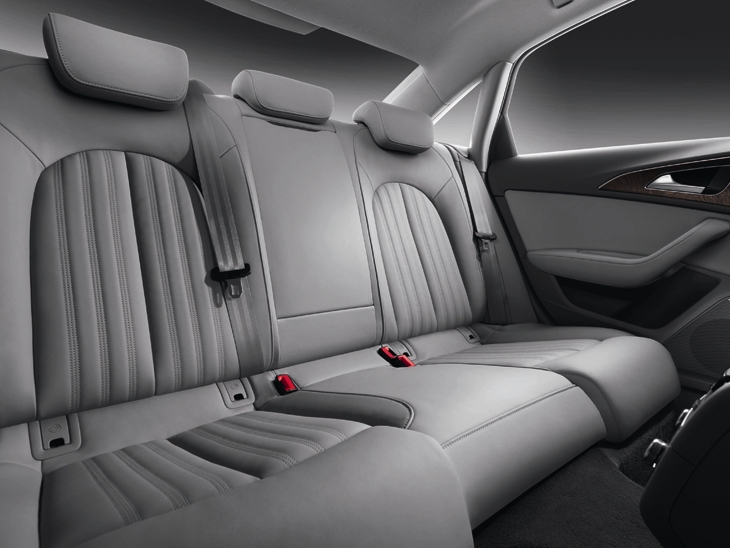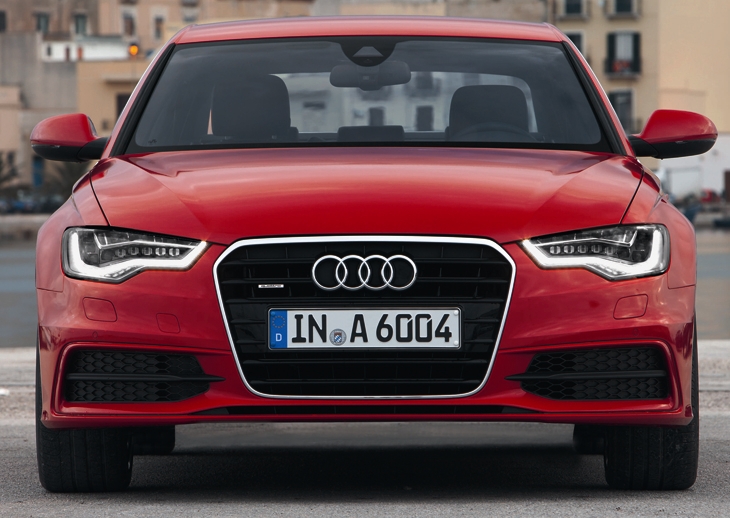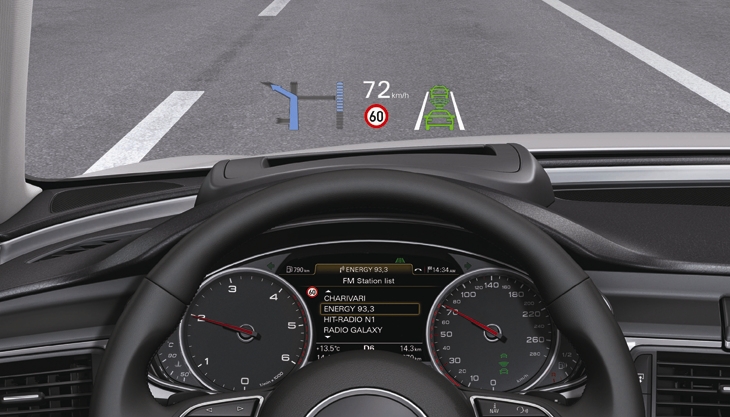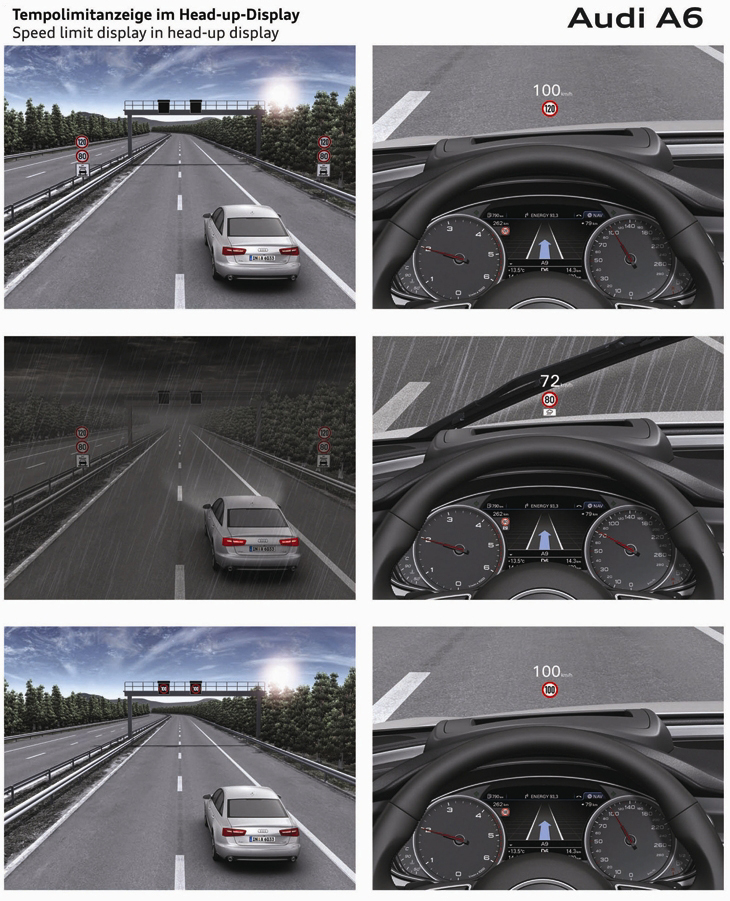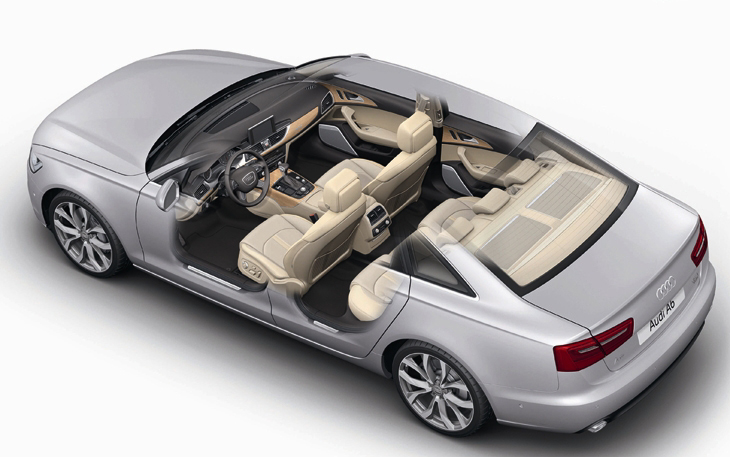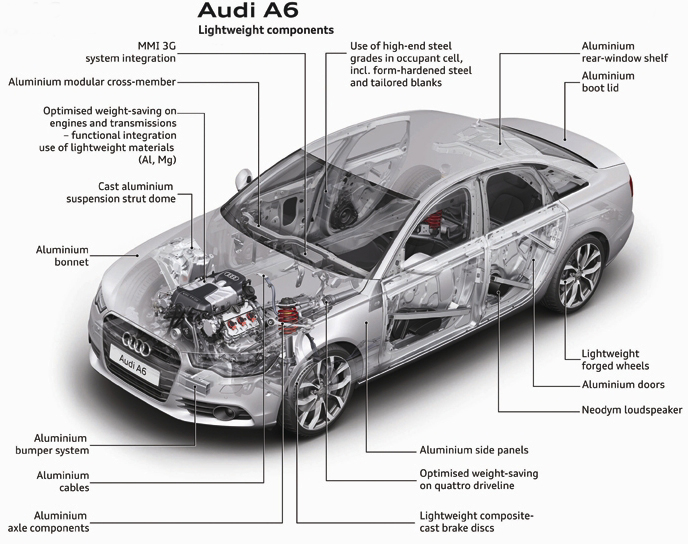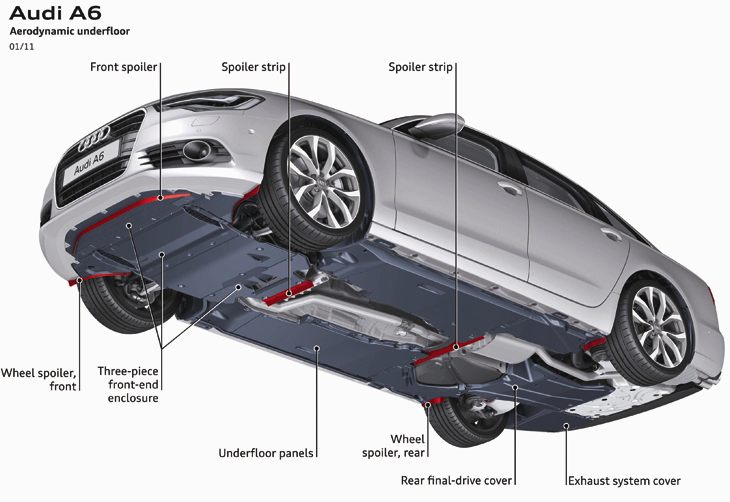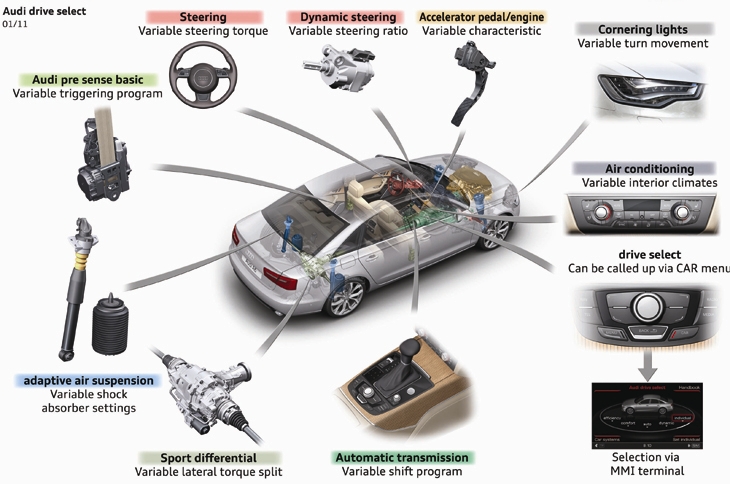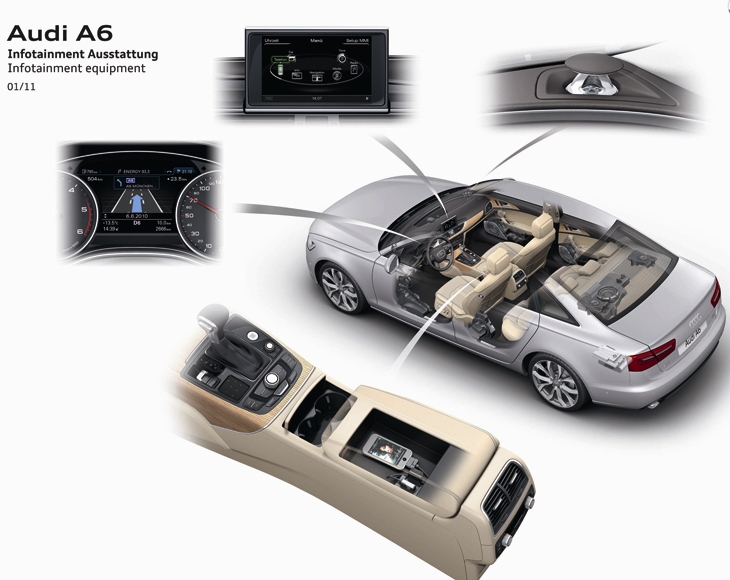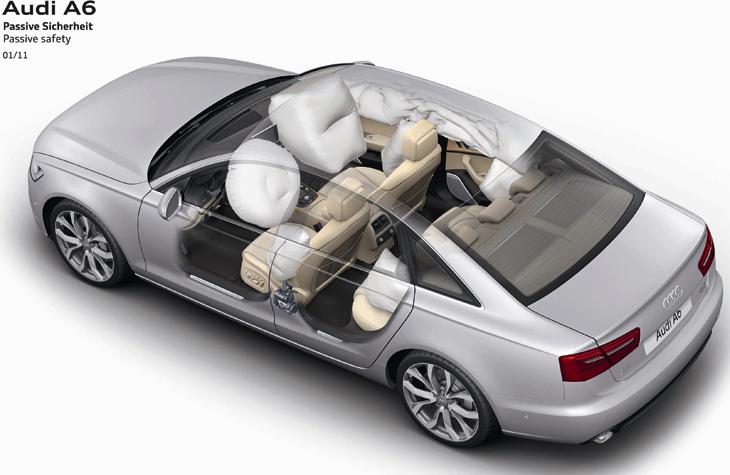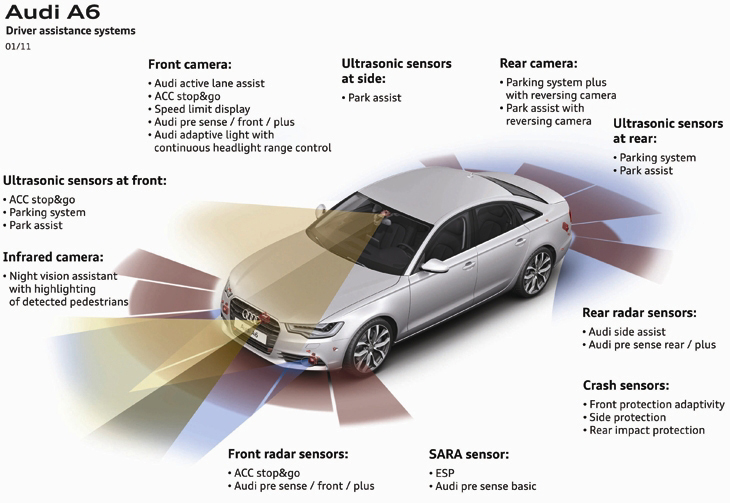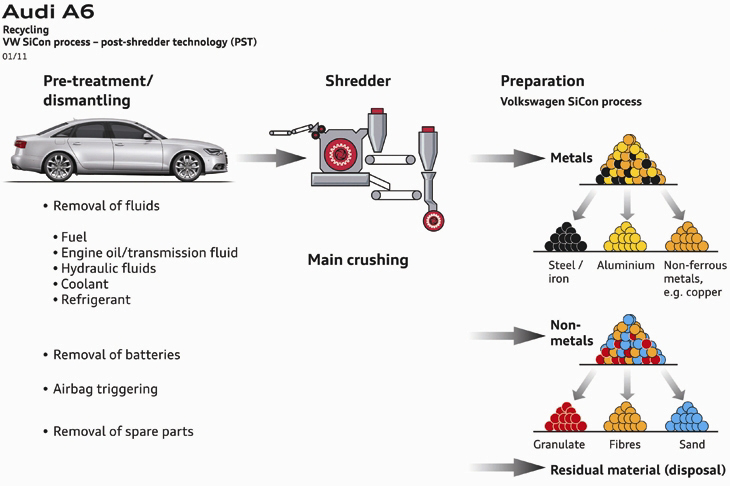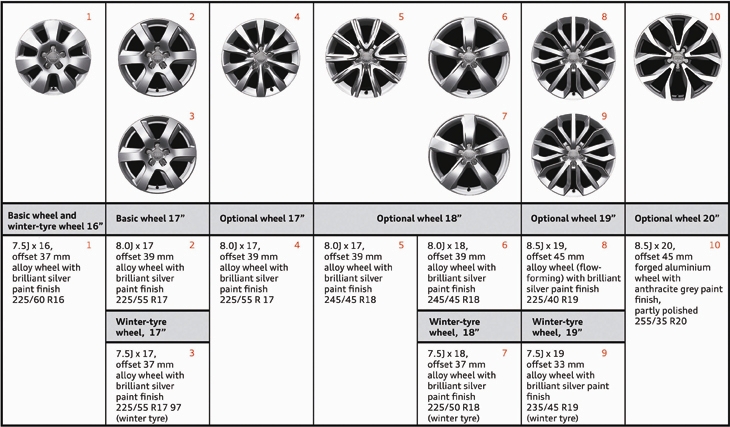|
|
|
|
The new 2011 Audi A6 - High-tech, precision and sporty elegance Audi has redesigned its flagship executive-class model. The new A6 is set to make its market debut in early 2011. With its light body featuring numerous aluminum components, sporty chassis and a wide array of new assistance and multimedia systems, the full-sized sedan is packed with innovative solutions in every area of technology. The range of available engines and drivetrains is equally extensive. Combining the power of a V6 with the fuel efficiency of a four-cylinder engine, the soon-to-be-available A6 hybrid will be a special highlight of the lineup.
At a glance Body
Interior
Engines
Chassis
Assistance and infotainment systems
The most advanced sedan in the executive class Once again, Audi sets the standard: The new A6 will arrive at dealerships in early 2011. The successor to the world's most successful executive sedan features groundbreaking solutions in every area of technology. The body is extremely light owing to a significant proportion of aluminum components. The range of assistance and multimedia systems is extensive, and operation is intuitive and user-friendly. The new Audi A6 is debuting with five powerplants: two gasoline engines and three TDI units. They have outputs ranging from 130 kW (177 hp) to 220 kW (300 hp). The Audi A6 hybrid will follow at a later date; it combines the power of a large V6 with the fuel efficiency of a four-cylinder engine. Audi also offers a number of drivetrain options. The Audi drive select dynamic handling system for all TFSI and TDI versions has been expanded to include an additional mode the efficiency program. With the new A6, which is the seventh generation of the model, Audi is revolutionizing the executive class. Featuring many technical innovations and lightweight aluminum design, this car will write the next chapter in the huge success story of the A6. The design embodies athleticism and elegance. The sedan is 4.92 meters (16.14 ft) long and 1.87 meters (6.14 ft) wide, but just 1.46 meters (4.79 ft) high the sportiest proportions in its segment. The long engine hood, the low, sweeping roofline, and the prominent lines on the flanks create a dynamic overall appearance. Optional LED headlights emphasize the striking expression at the front. The body of the new Audi A6 is exceedingly light, stiff and safe, thanks to an intelligent composite design concept. Numerous aluminum components and high-tech steels reduce its weight by some 30 kilograms (66.14 lb) compared with the previous model, making it the backbone of a systematic lightweight design concept. Depending on the version, the new executive sedan weighs up to 80 kilograms (176.37 lb) less than its predecessor. Audi the lightweight design pioneer of the international automotive industry has once again reversed the weight spiral, raising the bar for lightweight design. The A6 2.0 TDI, for example, tips the scales at a mere 1,575 kilograms (3,472.28 lb), not including the driver. The body features additional strong points. State-of-the art materials and design methods ensure extremely low interior noise levels. Precision tuning of all components and systematic hydraulic damping in the axle and drivetrain bearings provide excellent vibrational comfort. Powerful and highly efficient: the five engines The most efficient engine in the range is the 2.0 TDI. In conjunction with the manual transmission, it requires on average just 4.9 liters of fuel per 100 km (48.0 US mpg) and emits just 129 g CO2 per km (207.61 g/mile). The A6 hybrid will follow at a later date. Serving up 180 kW (245 hp) of system performance, its 2.0 TFSI plus electric motor will achieve sporty acceleration with an average fuel consumption of just 6.2 liters per 100 km (37.94 US mpg) (provisional figure). The Audi A6 is also available with a wide range of drivetrains another of the brand's great strengths. The choice, based on the engine version, will include a manual six-speed transmission, the continuously variable multitronic, and the brand-new, sporty S tronic. Each engine features a wide gear-ratio spread and low internal friction, thereby making a significant contribution to the sedan's efficiency. Depending on the engine version, power is funneled to the road via the front wheels or all four wheels. The quattro permanent all-wheel drive is presented in its latest stage of evolution its crown-gear center differential and torque vectoring function guarantee supreme traction, stability and dynamic response. For the top-of-the-line engines, Audi will soon offer the sport differential, which actively distributes torque to the rear wheels. Thanks to its sophisticated design, the chassis of the new A6 combines sporty precision with supreme comfort. Its links are made of aluminum; the power steering features a new electromechanical drive, making it highly efficient. The executive sedan has wheels ranging from 16 to 20 inches in diameter, with powerful brakes behind them. The Audi drive select dynamic handling system is standard for all engine versions; the ESP with electronic limited slip differential on the front-wheel-drive A6 models makes handling even more agile. For enhanced comfort, Audi also offers adaptive air suspension with controlled damping as an option. Dynamic steering will be available soon, also as an option. Sporty elegance: the interior Every detail of the interior is a testament to the care that Audi invests in carmaking. All materials, including an innovative layered-wood veneer, have been selected and crafted with the utmost care. As an option, the front seats can be equipped with ventilation and massage functions. Ambient lighting or the interior lighting package give the interior an added shine. The new Audi A6 features the logical ergonomics concept that distinguishes all of the brand's models. The efficient deluxe automatic air conditioning and the latest-generation MMI radio operating system are standard; Audi also offers an optional head-up display, which projects important information onto the windshield. The MMI navigation system plus with MMI touch is also available as an option. The hard-disk navigation system can be largely controlled via the touchpad. The online services, developed though a partnership between Audi and service provider Google, connect the full-sized sedan to the Internet via the Bluetooth car phone online. A UMTS module pulls images and information from Google Earth up on the monitor and integrates them with the navigation route. A WLAN hotspot provides contact to mobile terminals on board. The top of the hi-fi line is the Bang & Olufsen Advanced Sound System. MMI navigation plus works very closely together with the optional assistance and safety systems in the new A6. It forwards the route data to the control units for the headlights, the automatic transmission and the adaptive cruise control with stop & go function. This enables these systems to recognize complex scenarios and assist the driver. In many situations, the Audi pre sense safety system is able to minimize accidents and their consequences, or even prevent them altogether. The Audi active lane assist helps the driver to keep the A6 on course, and the park assist system relieves the driver of the chore of steering when parallel parking.
Interior Elegant forms, supreme comfort, a logical ergonomics concept and extensively networked intelligence: In the interior as well, the new Audi A6 documents its leadership role in the executive class. In its display concept, the new head-up display is a special highlight. The interior of the A6 is an emotional space full of expanse and lightness. Its lines take up the sinewy sportiness of the exterior. The defining element of the cockpit area is the wrap-around inlay, beginning at the driver's door and running in one large arc beneath the root of the windshield, then all the way to the front passenger's door. Curved elegantly around the driver's seat, the instrument panel with its large application area rounds out the concept of sweeping lines. The wide, asymmetric center console is oriented toward the driver. The sporty seats in the A6 are mounted low, yet most drivers can see the entire engine hood thanks to the low front end, which reinforces the impression of open expanse and freedom. The new Audi A6 offers space in abundance. The comfort-optimized door arrester and the long, low doors make getting into the car easy for all occupants. Audi also offers an electric power closing option. At every seat, there is plenty of headroom, elbow room, legroom, and footroom, even for tall people. Compared with the previous model, the head clearance at the front, interior length and shoulder width have all increased slightly. The headrests in the rear compartment can be positioned extra low to avoid obstructing the view from the interior mirror. The optional electric roller blind for the rear window, which extends and retracts along tracks in the C-pillar paneling, provides nearly complete shading of the window. The blinds for the rear side windows are operated manually. Redesigned: the front seats Audi also offers a host of attractive options. The sport seats with contoured side bolsters have seat cushions that can be adjusted in depth and inclination; they provide electric four-way lumbar support. The lumbar support is also available separately, as are seat heaters for the front seats or for all four seats. The fully electric adjustable front seats are equipped with a memory function for the driver's seat. The highlight of the A6 amenities are the comfort seats, featuring electric adjustment plus memory function for both seats and outside mirrors. Their backrests, side bolsters and lumbar support can be adjusted pneumatically. On request, Audi will upgrade the comfort seats with a ventilation system for the seat surface and backrest that makes use of a novel and particularly effective aspiration technology. The technology employs four fans that can be operated at three levels. Also available is a massage function featuring ten air cushions, five programs and four intensities to pamper the back. Only a few switches are needed to operate the seats. All primary adjustments are made using switches that mirror the shape of the seat. A multifunction switch controls the secondary functions, such as adjusting the side bolsters or the massage function, with the MMI monitor showing each step. The new Audi A6 offers plenty of spacious, practical storage features. The locking glove box is very large, and the front door pockets can accommodate one-liter bottles. Two additional cupholders are located on the center tunnel, where there is also a center armrest plus storage compartment with continuously variable tilt adjustment. In the back is an additional armrest with a small storage compartment. A 12V socket, drawers under the front seats and nets on the front-seat backrests round out the range of storage amenities. Audi also offers an optional storage package, which includes two cupholders in the rear armrest, two sockets in the rear compartment and a net for the luggage compartment. All functions under control: vehicle operation Starting with the trim level that includes the MMI radio plus, the new Audi A6 comes equipped with the driver information system, with either a 5-inch or 7-inch screen and a monochrome or color display, depending on the version. The system combines all key information and settings in an intuitive menu structure that works with one main area and two additional info bars. These can be easily read without requiring the driver to look away from the road for long. Integrated into the driver information system is what Audi calls the efficiency program. It shows the contribution each technological component is making to fuel efficiency and also gives the driver tips for fuel-efficient shifting a practical feature, given the fact that driving style accounts for approximately 30 percent of overall fuel consumption. The driver information system is operated via the standard leather multifunction steering wheel. This latest-generation concept featuring two additional paddles enables convenient operation of the telephone, audio devices and onboard computer. Audi offers a number of different steering wheels with three or four spokes, shift paddles for the automatic transmission, a heated rim and a power adjustment system with an easy entry feature. The skeleton of each steering wheel is made of ultra-light magnesium materials. The center console is home to a series of secondary switches, the slot for the CD or DVD player and the memory card slots. The lower section of the console contains the control unit for the deluxe automatic air conditioning system, with rotary controls surrounded by red and blue LEDs. The system provides indirect ventilation with virtually no draft. It takes into account the position of the sun and has a moisture sensor to prevent window fogging. Powerful and efficient: deluxe automatic air conditioning The brushless fan motor requires little power and is both small and light. The internal heat exchanger is a coaxial line, with the intake end on the inside and the discharge end on the outside. The heat exchange between the two ends boosts the performance of the evaporator. The refrigerant mass flow is reduced, which in turn reduces the power consumption of the compressor. Thanks to a new oil separator, it does not have to continuously circulate lubricant and cooling oil. The deluxe automatic air conditioning continuously analyses humidity levels in the inside and outside air to determine the optimal mixing ratio for the lowest energy consumption. Audi also offers an optional four-zone deluxe automatic air conditioning system, featuring a separate control panel and display for the rear passengers. Throughout the interior, three climate-control styles can be chosen mild, medium and intense. For winter a fourth variant is available, which directs lots of heat to the footwells. A residual heat function uses the heat of the engine when the A6 is parked. As an option, Audi also offers a programmable auxiliary heater with a novel operating concept. All the customer needs to do is choose a time to start the car, and the control unit does the rest. Its intelligent strategy lowers electricity and fuel consumption by 30 to 50 percent. The center tunnel console in the new Audi A6 features additional controls. The standard start-stop button replaces the ignition switch the key can stay in your pocket. The system can also include a convenience key for keyless vehicle entry. The pushbutton for the electromechanical parking brake, which can act as an emergency brake when the vehicle is in motion, and the terminal for the Multi Media Interface (MMI) operating system are also located on the center tunnel console. Audi offers the MMI radio version as standard. Intelligent ergonomics: the MMI operating system The large onboard monitor for the MMI system comes with a standard 6.5-inch screen or an optional 8-inch screen. It is surrounded by a high-gloss black frame. In standby mode, the onboard monitor is recessed in the center of the instrument panel, with only its chromed top edge visible as a decorative molding. When the ignition is switched on, the monitor extends forward, then upward and outward in a gentle movement at graduated speed. Just like the optional driver information system, the MMI display is divided into three zones, and the menu control system follows a clear logic. The new selection menus, called wizards, have an especially classy appeal thanks to the circular arrangement of their icons. Elegant three-dimensional graphics and newly introduced animations give a striking presentation of the menu hierarchy. All information at a glance: the head-up display To assimilate the information, the driver does not need to look away from the road and the eyes, accustomed to distance vision while driving, do not need to adjust. It takes only about half as long to look at the head-up display as it does to read the display on the instrument cluster an important advantage especially at higher speeds. The MMI system can be used to program which information will be shown on the head-up display such as speed, navigation symbols, lists from the infotainment systems or indicators from the assistance systems. The speed limit display and night vision assistant also make use of the system. Audi is the first manufacturer in the world to offer a full-color head-up display with TFT screen technology. In addition to red-green-blue color filters, new polarization filters are used; their high contrast is sufficient even for difficult lighting conditions. 15 blue-white LEDs provide especially bright backlighting for the TFT monitor on which the images are generated. A sensor in the base of the interior mirror adapts the display to the brightness of the surroundings. The driver can also adjust it at any time. The light-emitting diodes and all other components have extremely low energy requirements. All components are designed to easily withstand the temperatures that arise in the head-up display. The system requires no active cooling mechanism an additional efficiency-enhancing factor. The windshield onto which the image is projected acts as a concave mirror; it enlarges the picture, creating certain distortions in the process. Two curved corrective mirrors in the light path, made of plastic with a special coating applied, even out these distortions and increase the optical imaging capacity. These new technologies from Audi keep space requirements low and give the designers free reign when designing the windshield. To avoid ghost images, the windshield and its noise-insulating safety film have a minimally tapered design. When windshields are manufactured, tiny deviations from the ideal surface are impossible to avoid. Although only a few hundredths of a millimeter in size, such imperfections would produce a slightly uneven image on the head-up display. Audi has come up with a solution to avoid this effect: During production of the A6, the display is precisely calibrated to the windshield for each car. Handcrafted quality: the finish Chromed bezels frame the air vents, fine aluminum-look strips accentuate the optional fine wood bezels. The buttons have an appealing black soft-touch finish; the aluminum look turns the control knobs into miniature works of art. The shift gate and the start-stop button feature subtle red backlighting, and the door sills have aluminum inlays. The upper section of the instrument panel is covered in a soft-backed, leather-look material. The frequently used components in piano finish black in the Audi A6 are coated with a novel, UV-cured topcoat making them extremely scratch-resistant. Audi is offering a wide range of decorative elements, colors and upholsteries at the launch of the A6. In addition to the standard and optional fabric upholsteries, the selection also includes the robust and durable Milano leather and the high-grade Valcona leather, whose varnish application only lightly covers the skin structure, allowing the material to breathe. Another fine alternative is the Alcantara/leather combination. A leather package for the center console, the door armrests and the door pulls round out the selection. The seat coverings are available in black, goa beige, nougat brown, titanium gray and velvet beige, the roof lining in black, silver and beige. The interior comes in black, gray, brown and beige hues. The sedan is fitted with micrometallic platinum inlays as standard; Audi also offers trims in Aluminum Trigon as an alternative. Two wood veneers brown, open-pored fine grain ash and dark brown walnut are available. An especially classy variant are the inlays in piano finish black. A novel veneer of layered oak will be available soon. Using a technique developed especially by Audi, it is cut from a block in which extremely thin layers alternating between untreated and dark-stained wood lie one over the other. A special treatment at the end of the process produces a fine finish. The S line sport package gives the interior a particularly elegant look. The sports seats are upholstered in Valcona leather; combinations of perforated Alcantara and leather are available as an alternative. The upholstery, as well as the carpeting, the instrument panel and the roof lining are draped in black, with stitching adding visual touches. The inlays are in matt brushed aluminum; S line badges gleam on the fenders and door sills. The steering wheel is specially designed, and the selector lever is wrapped in perforated leather. Sport suspension with 18-inch or 19-inch wheels rounds out the package. Emotional effects: the interior lighting Another option is the ambient lighting, a complete emotional orchestration that uses light guides in many areas. It provides a series of additional effects around the door sills, the door pockets and the reading lights in the rear compartment. Dramatic lighting makes the console on the center tunnel appear to float. When it's dark outside, the ambient lighting whose luminous power can be configured via the MMI gives the interior a larger, more expansive appearance. When the A6 is unlocked, the lighting in its interior illuminates in a wavelike pattern, starting with the driver's seat. When a door is opened, it focuses on the corresponding seat. The large, roomy luggage compartment in the new A6 is the same in the front-wheel-drive and quattro-drive models. The luggage compartment is precisely lined with fine carpeting, and its low loading lip and wide loading aperture make it easy to use. It provides a loading width of 1,050 millimeters (41.34 in) and a volume of 530 liters (18.72 cu. ft), enough for four large suitcases or four golf bags. Audi also offers an optional rear seat back with a 40/60 split. The trunk opens automatically when unlocked. Two bag hooks, four solid, chrome-covered lashing hooks and a practical bin in the right wall of the luggage compartment help to get things stowed. A reversible mat with a rubberized back, a locking load-through hatch with ski bag and an electric drive for the trunk lid are available as options. With the optional trailer hitch, the new Audi A6 can tow up to 2,100 kilograms (4,629.71 lb). If the trailer starts to fishtail, an additional function of the electronic stabilization program (ESP) intervenes. By applying the brakes to the sedan's wheels in opposite phases, it brings the fishtailing motion back under control.
Multimedia systems In navigation of infotainment technology, the Audi A6 is setting new standards in its class. Audi offers a modular system of components, with the top spot in the lineup occupied by the MMI navigation plus, with its groundbreaking touchpad, the MMI touch. The standard version, MMI radio, has a single CD drive that can also read mp3, WMA and ACC formats. Two antennas ensure good radio reception, and eight passive speakers ensure high-quality sound. The optional MMI radio plus, the first version, adds two SDHC card readers, a Bluetooth interface for a telephone and a 5-inch version of the driver information system. Sound is output via the Audi sound system. A six-channel receiver pumps 180 watts of power to ten speakers, including a subwoofer and a center speaker. At the heart of the MMI Radio plus system is a high-performance dual-core processor. VHF reception is improved with a dual tuner and digital signal processing. MMI Navigation, the third version, comes equipped with dynamic route guidance. The data and dynamic navigation come from an SD card, and the voice control system is standard. The MMI navigation unit features an additional third tuner, which is just for the reception of TMC traffic messages. Top-of-the-line: MMI navigation plus A dedicated 3D graphics processor from NVIDIA, the market leader, generates the three-dimensional images in top quality. The map is a high-resolution 3D model with points of interest in many cities recreated in great detail. The driver can choose between route guidance using the classic arrows or a new, animated display rich with detailed information. MMI navigation plus uses an 8-inch diagonal onboard monitor instead of a 6.5 inch diagonal monitor. Thanks to its high resolution of 800 x 480 pixels, the large screen delivers extremely sharp images in vibrant colors. Graphics, including the cover art for the audio titles, are elegantly sculptured. Just like a notebook: MMI touch The push of a button transforms the pad into a control panel containing six freely selectable radio stations. From a technical perspective, it comprises a sensor module and a computer located beneath. A processor recognizes the symbols drawn by the driver and passes them on to the MMI system. The sensor module is made up of a touch-sensitive film criss-crossed by many conductors and a face plate, illuminated from below by white high-performance LEDs. A special coating ensures that the face plate can withstand 600,000 input operations without noticeably degrading its classy appearance. Along with MMI touch, the A6 also offers the familiar Audi operation with the MMI rotary pushbutton. Finally, the system also features advanced voice control that allows the city and the street to be entered as a spoken command. It can also access the phone and music data on the hard disk. The new MMI navigation plus works very closely with the assistance and safety systems on board the new A6. Its database precisely describes the entire European road system. The navigation system analyses these data predictively, reading the current course of the sedan in advance. The information is relayed via a data bus to the computers managing the ACC stop & go function, the headlights and the S tronic or multitronic transmission so that these systems can precisely adapt their function to conditions well in advance. Audi offers a wide selection of modules to supplement this system. These include a CD or DVD changer in the glove box, a dual tuner for digital radio reception (digital audio broadcasting, DAB) and an analog/digital TV tuner. The Audi music interface conveniently integrates a modern mobile player or an iPhone into the on-board audio system. The Bluetooth mobile phone preinstallation includes a hands-free system that can be operated via the MMI, the voice control system or the multifunction steering wheel. An AV adapter for video and image sources will be available later. Terminal devices are connected via USB adapters. A rear seat entertainment system with two 10-inch monitors is also coming soon. High-end sound: the sound systems The top version, the Advanced Sound System from Bang & Olufsen, ups the ante with two amplifiers and 1,300 watts of power. This system from Denmark's audio specialists delights even critical hi-fi connoisseurs with a broad, finely differentiated frequency range, powerful base notes, transparent mid-tones and crystal-clear highs. Bang & Olufsen sound technology is so complex that more than 1,200 parameters are influenced by the individual settings of the users. The proprietary Upmix algorithm distributes stereo signals across up to seven channels and can simulate acoustic reflections just like in a concert hall. The amplifier for the subwoofer is particularly energy-efficient thanks to the manufacturer's ICE technology. It is also compact and lightweight. The Advanced Sound System integrates 15 active speakers with polished-aluminum housings. The front doors contain boxes, which do not emit any frequencies via the sheet metal surfaces. Recessed in the instrument panel are two elegant acoustic lenses for the high frequencies. They extend outward when the system is switched on.
Internet connection Audi has opened up a large lead over the competition in terms of complete, fast Internet access. While on the road, A6 passengers can surf and send e-mail to their hearts' content, and the driver can take advantage of many attractive online services provided by Google. The new technologies are concentrated in the optional Bluetooth car phone. At its heart is a UMTS module located in the MMI navigation plus head unit. Communication takes place via the roof antenna, ensuring a strong connection. Thanks to a special modulation method called High Speed Downlink Packet Access (HSDPA), data transfer via UMTS is very fast up to 7.2 MB per second. Encryption with the WPA2 standard provides a high level of security. In rural areas, the UMTS module switches to the EDGE connection technology. It is slower, but because it utilizes the GSM network, it provides nearly uninterrupted coverage. The Bluetooth car phone online incorporates a WLAN hotspot. It enables the front and rear seat passengers to simultaneously connect as many as eight terminal devices from a laptop to an iPad to the Internet, regardless of their operating system. All the driver of the new A6 needs to go online is a data-capable SIM card. The card reader is located in the MMI navigation plus trim. Alternatively, the driver can connect a private cellular phone to the system via Bluetooth if the phone supports the SIM Access Profile. No additional fees or special contracts are required; Audi does recommend a flat rate, however, due to the large amounts of data involved. The Bluetooth car phone online offers a range of convenient services. A6 drivers can plan their travel routes on their computers at home or in the office, upload them to a section of the Internet site www.audi.de and from there download them to the navigation system via UMTS on starting the trip. Through the fast connection the A6 also downloads three-dimensional satellite images and aerial photos from Google Earth another groundbreaking innovation from Audi. These appear in a bird's eye view on the monitor, and the computer fills in the roads. A large amount of additional information is delivered to the car with the images. In addition, the Bluetooth car phone online also allows the car to retrieve specially prepared news, weather information and points of interest from Google maps. The online system is operated via the voice control system, the MMI navigation plus or the multifunction steering wheel. For discreet telephoning, a separate Bluetooth handset is available. Audi online traffic information: always in the know With Audi online traffic information, the very latest real-time traffic data is displayed on the navigation map via the vehicle's Internet access, and taken into account when calculating the route. If traffic is free-flowing, the route is highlighted in green on the MMI monitor. It turns yellow if traffic is heavy, orange if traffic is stop-and-go, and red if traffic is backed up. This information is displayed in addition to the symbols already familiar from the Audi navigation systems, such as those that indicate construction sites and lane constrictions. It is a significantly faster and much more accurate system than current TMC solutions. Secondly, Audi has added another function to the range of online features. The latest-generation voice command function now makes it easy to perform simplified searches for Points of Interest (POI) via an Internet connection and Google Search. A brief voice command directs the system to find the desired destination, allowing the driver to focus on traffic at all times. In 2010 Audi set the standard in online connectivity a leading position evidenced by the "Best Embedded Navigation Telematics Product" award for the A7 Sportback and A8 model lines. Audi will continue to expand this impressive offering in the future.
Driver assistance systems Audi offers a broad portfolio of optional assistance systems for the A6. Their tight integration with one another and other systems in the vehicle imbue them with maximum versatility, intelligence and performance. Particularly over long distances, these systems make driving more relaxing, easy, and pleasant. The electronic network in the sedan is so complex that is has been endowed with a new architecture: The FlexRay bus system interlinks numerous control units from the driver assistance and chassis areas, significantly increasing the speed at which data is transferred between them. At the center of the action: ACC stop & go The ACC stop & go makes use of a groundbreaking networking system in the vehicle to analyze data from up to 26 other systems. Its key information, however, comes from the two long-range radar sensors beneath the front of the vehicle, which operate in the frequency range of 76 to 77 GHz. They scan a field 250 meters (820.21 ft) long with an angle of aperture of 40 degrees. A small video camera in the base of the interior mirror looks ahead approximately 60 meters (196.85 ft), also with a 40-degree angle. With this high level of information, the system can recognize complex scenarios and predictively support the driver. It also uses the predictive route data from the navigation system so that it can also reliably calculate the proper line on the highway even in curves. Whether changing lanes, on curvy interurban roads, passing or turning off, the ACC stop & go function resolves the situation as judiciously and confidently as an accomplished driver, making driving even more fluid and harmonious. Its range of application also includes stop-and-go city traffic, where the system conveniently slows the sedan down to a stop. To start the car off again automatically, the system uses signals supplied by the ultrasound sensors for the park assistance system located in the front bumper. Just to be on the safe side: Audi pre sense In the standard version Audi pre sense basic, the system becomes active when it detects an unstable driving situation via the sensors of the ESP electronic stabilization program. In such cases, it ensures the front seatbelts are electrically tensioned and the sunroof and the side windows are closed, leaving just a small gap. Audi pre sense front comes standard in combination with ACC stop & go. Its job is to prevent potential rear-end collisions with the vehicle ahead at speeds above 30 km/h (18.64 mph) or to mitigate the consequences of such accidents. The integrated Audi braking guard is activated in a dangerous situation to warn the driver, first with an acoustic and a visual signal. Parallel to this, the brake system is prefilled and the dampers of the optional adaptive air suspension are set to hard. If the driver remains passive, a warning jolt the brief activation of the brakes is performed in the second stage. The seatbelts are lightly tensioned at the same time. If the person at the wheel steps on the pedal at this point, the hydraulic brake assistant increases the brake power appropriately for the situation. If the driver ignores the warning jolt, the system autonomously applies partial braking to slow the sedan down at a rate of 3 m/s2, provided the car ahead is in motion. Windows and the sunroof are closed, the adaptive brake light is activated and the seat belts are tensioned. If the A6 is equipped with the full version of Audi pre sense Audi pre sense plus, which is part of the assistance package a third and a fourth stage follow in the event of an emergency. The system now increases deceleration to 5 m/s² and tightens the belts completely. The last braking phase autonomous full braking occurs roughly half a second before an inevitable collision. The collision and its consequences are greatly reduced, because by the time the impact occurs the sedan can reduce its speed by as much as 40 km/h (24.85 mph). Another subfunction, Audi pre sense rear, is coupled with Audi side assist. If the system detects an imminent rear-end collision, it uses the adaptive brake light to warn the traffic behind. Preventive protective measures are activated if the situation turns critical. Lane-changing made easy: Audi side assist Always on track: Audi active lane assist If the sedan approaches a line without the turn signal being activated, the system helps the driver to steer back into the lane by intervening gently in the electromechanical steering. The driver uses the MMI to determine how soon the intervention occurs and whether it should be combined with steering wheel vibration and a warning tone. If the car is in danger of skidding, Audi active lane assist supports countersteering by briefly boosting or reducing the degree of power support. The system can also take objects in the adjacent lane into account and incorporate them into its strategy. It also uses steering movements to determine when the driver's concentration begins to lessen and adjusts its interventions accordingly. Know more: speed limit display See farther: night vision assistant The far infrared camera is integrated into one of the Audi rings on the single-frame grill. Depending on the car's speed, it can see as much as 300 meters (984.25 ft) ahead with its 24-degree angle of aperture, far beyond the range of the high beams. A protective window protects it from flying stones. It is heated in cold weather and cleaned along with the headlights when dirty. Whereas the cooler road appears dark, animals and people are shown eye-catchingly brightly due to the heat they radiate. The image-processing software, which specifically targets objects such as heads, can detect them at up to 100 meters (328.08 ft) away and highlights them with yellow markings on the display. If the computer assumes a hazardous situation, the person is marked red and a warning signal sounds. The red marking also appears optionally in the head-up display. Like every assistance system, the night vision assistant also works within certain, very liberal system limitations. Automated parking: park assist The park assist system maneuvers the A6 into both parallel and perpendicular spaces relative to the road. When parallel parking, the space must be just 0.80 meters (2.62 ft) longer than the car. If necessary, the system will make multiple maneuvers, forward and backward. It assists in the same way when leaving the parking space. The maximum parking speed is 7 km/h (4.35 mph). In addition to the new park assist system, Audi provides two additional solutions to help the driver when parking: parking system plus with acoustic and visual cues and the reversing camera, which operates with a fish-eye lens. Aided by a software program, it displays a distortion-free image of the area behind the A6 on the MMI monitor, along with supporting projection lines and surfaces.
Equipment and trim The new Audi A6 offers all the comfort of the luxury class. An extensive selection of standard features and attractive options will already be available at sales launch. Comfort and convenience features include the two-zone deluxe automatic air conditioning system, the start-stop button for the engine and the four-spoke leather multifunction steering wheel. In addition, at no extra charge, the new A6 offers the MMI radio with 6.5-inch monitor, a light and rain sensor, and electromechanical parking brake, an auto release function, a cruise control system and an acoustic-insulating front windshield. Armrests in the front and back and a number of storage compartments provide for added comfort. The exterior boasts a striking high-gloss package around the side windows and elegant alloy wheels in 16- and 17-inch format (depending on the engine version). A control function monitors the tire pressure. The adaptive brake light warns drivers behind when the emergency brakes are applied. The housing of the power-heated and power-adjustable exterior mirrors sport LED turn signals. The safety package comprises two front, two side and two head airbags, four belt tensioners, the integral head restraint system, five head restraints and two Isofix fixtures in the back for child seats. The Audi pre sense basic system rounds out the safety equipment. The standard Audi drive select dynamic handling system is intended especially for sporty drivers. The two top-of-the-line engines in the new model line transmit power to the road via the fast-shifting seven-speed S tronic and the latest-generation quattro permanent all-wheel drive. The front-wheel drive models come with the ESP stabilization program and an electronic limited slip differential. The energy recovery system and the start-stop system help to reduce fuel consumption in all units. Just like the luxury class: optional extras Other luxurious options include two lighting packages, the convenience key for easy access, a power servo function for closing the doors, power folding exterior mirrors, a garage-door opener and an automatic anti-dazzle interior mirror. Audi also offers optional insulating/acoustic glazing tinted upon request and a glass sunroof. The seating options are also luxurious, ranging from a power lumbar support to the sport seats and the comfort seats with optional heating and massage. Side airbags for the rear seats are available as an option. A storage package brings order to the interior and the luggage compartment, and a power trunk lid makes loading even easier. Audi has prepared a large number of special features for those who appreciate the exceptional: a leather package, various sophisticated upholsteries and inlays, and an S line sport package that drapes the interior in black. It is combined with sport suspension, 18-inch or 19-inch wheels, sport seats and a special steering wheel. For an even sportier look, there is the S line exterior package. Audi offers two different sport suspensions for dynamic drivers. The sport differential completes the quattro drive. For the front-drive versions, the continuously variable multitronic is available. Shift paddles on the steering wheel make the automatic transmissions even sportier to use. The adaptive air suspension combines luxurious ride comfort with impressive agility. The wheels are available in sizes up to 20 inches with 255/35 tires. Lighting technology is a particular Audi strength. The adaptive light with variable headlight range control is available for the A6 with xenon plus headlights. The top version in the range are the LED headlights, which use light-emitting diodes for all functions. In addition, Audi also offers LED technology for the rear lights. Particularly extensive is the line of driver assistance systems. At their very heart is the adaptive cruise control with stop & go function including Audi pre sense front a high-end radar cruise control with warning system. Audi side assist including Audi pre sense rear monitors traffic behind the new A6 and provides information to help the driver when changing lanes. Audi active lane assist enables to driver to stay in the lane with effortless ease, the speed limit display detects many traffic signs, and the night vision assistant with highlighting of detected pedestrians looks far ahead into the darkness. For convenient parking, a number of solutions are available, including the automated park assist system. The assistance package including Audi pre sense plus combines the most important systems. In infotainment and Internet technology as well, the new Audi A6 is ahead of the competition. Audi offers numerous advanced components all the way up to MMI navigation plus, with its groundbreaking operation via the MMI touch. The Bluetooth car phone online connects the passenger to the Internet via UMTS and a WLAN hotspot.
Exterior design Elegant and timeless in the Audi A6, the styling of its predecessor is carried over and further enhanced. The long engine hood, sleek styling and the low, coupe-like greenhouse with its smooth transition to the rear section are classic features of the model line. The design of the A6 portrays the aesthetics of technology in the precision with which the lines are drawn and the athletic tautness of the surfaces. The new sedan measures 4.92 meters (16.14 ft) in length, with a 2.91-meter (9.55 ft) wheelbase. It is 1.87 meters (6.14 ft) wide and 1.46 meters (4.79 ft) high the sportiest proportions in the executive class. Compared with the previous model, the new A6 comes in a few millimeters shorter and lower; its wheelbase, however, has grown significantly, whereas the front overhang is now 8 centimeters (3.15 in) shorter. Painted a high-gloss black, the large, low single-frame grille featuring beveled upper corners merges neatly with the sculptured front end. It is the defining element of the front end. The horizontal orientation of the louvers underscores the width of the latest A6, as do the wide, low air intakes. Tapered in shape and becoming broader as they extend outward, the headlights take up the slanted lines of the single-frame grille. The way in which they angle into the engine hood gives the new A6 a determined, energetic look. The bottom edge forms a wavelike contour. Regal lines: the side view The tornado line, the dominant design element of the A6, extends over the entire flank and defines the proportions. It forms a prominent shaded edge, lending strength to the body's shoulders. The tornado line starts at the headlights and extends along the fenders, the doors and the rear side walls to the tail lights. Above the side sills lies the dynamic line, which turns up slightly at the rear of the car. Wheels ranging from 16 to 20 inches in diameter fill the energetic wheel arches. The LED turn signals integrated into the outside-mirror housing and the reach-through door handles symbolize reliable safety. A high-gloss package featuring window capping strips in anodized aluminum and black trim for the B-pillars brilliantly accentuate the greenhouse. The flowing lines end in a three-dimensionally sculpted rear section. Trapezoidal lights emphasize the width; divided into two parts, their styling echoes the trapezoidal shape of the headlights. The trunk lid bears the outline of a spoiler lip. The matt black diffuser insert envelopes the two large, round tailpipes for the exhaust system. This solution also emphasizes the width of the A6, as does the light-catching contour above the diffuser. The optional S line exterior package gives the car an even sportier look, with more prominently featured bumpers, grilles on the air intakes, and diffuser insert. The diffuser and the center edge of the front spoiler are painted gray; the fenders and the door sills sport S line badges. The sill panels stay the same color as the body. Audi offers a choice of twelve paint finishes for the new A6. The solid colors are called Ibis White and Brilliant Black. The metallic hues bear the names Aviator Blue, Dakota Gray, Ice Silver, Havana Black, Moonlight Blue, Oolong Gray and Quartz Gray; Glacier White will follow at a later date. The pearl-effect colors Garnet Red and Phantom Black round out the selection. Technical works of art: the headlights The xenon plus technology includes an LED daytime running light strip and new all-weather lights, generated by intelligent control of the light modules. The all-weather lights replace the fog lights, whose traditional location in the air intakes is occupied by the radar sensors of the optional adaptive cruise control with stop & go function. Their range is 60 meters (196.85 ft) four times greater than conventional fog lights. In addition, they use considerably less energy. Audi also offers the xenon plus headlights with the optional adaptive light system, which always provides the appropriate lighting, whether driving in the city, on interurban roads or on the highway. The system includes a dynamic cornering light, a static cornering light and variable headlight range control, which uses a small video camera in the base of the interior mirror to detect the light of other vehicles and localities. The system adapts the vehicle's own light by swiveling the xenon modules with soft transitions. This allows it to switch harmoniously between the low and high beams and guarantees maximum illumination for the driver at all times. The headlight control unit is closely networked with the optional MMI navigation plus system. The navigation system relays route data to the light computer to activate highway lighting while still on the ramp to the highway, for example. Before entering an intersection, the system automatically switches on the cornering light, and in countries like the United Kingdom, it switches the headlights from driving on the right to driving on the left. On hilly interurban roads with cambers and dips, the active topography compensation system comes into play it improves the driver's own view and prevents other drivers from being blinded. High-tech from Audi: the LED headlights Low-beam light in the new Audi A6 is produced with four one-chip LEDs and five two-chip LEDs located in nine reflector/lens modules below the wing. Generated by three four-chip LEDs, the high-beam light is housed above the wing. A separate four-chip LED generates the cornering light. The LED headlights also include all-weather lights, which make use of a number of interacting electronic and electromechanical components. Audi has replaced moving parts with intelligent control. To create highway lighting, stepper motors are used to increase the light/dark boundary of the low-beam light at vehicle speeds of 110 km/h (68.35 mph) and above, thus extending the light cone from a range of 70 meters (229.66 ft) to 120 meters (393.70 ft). The integrated high-beam assistant switches automatically between the low and high beams. The daytime running lights and turn signal are located in a curved strip at the bottom edge of the headlight. A superposed plastic component provides the thick wall technology that makes them appear as homogeneous strips of light. The daytime running lights are generated by 24 white LEDs. Blue LEDs which emit yellow light due to a technical trick are responsible for the turn signal lights. In combination with the xenon plus and LED headlights, Audi also offers tail lights with LED technology, giving a three-dimensional effect to their light pattern. The rear lighting system is made up of 60 LEDs and is deflected by the same number of reflectors. Light-scattering technology makes it appear as a visually continuous band in the form of a broad, U-shaped arc. The large brake light in the center of the lights employs 50 red LEDs. The turn signal lights, comprising 56 yellow LEDs, form a strip that runs across the upper edge. Incandescent lamps illuminate the reversing lights and the rear fog lights.
The Body The body of the new Audi A6 is at the top of its vehicle segment. A composite steel-aluminum construction, the body weighs approximately 15 percent less than a conventional all-steel construction. Its stiffness, vibration characteristics and crash performance are impressive, as are its aerodynamics and aeroacoustics. Audi has used new construction methods and materials for the body. Aluminum parts With its many aluminum components at the front end of the car the composite design concept improves the axle-load distribution and is supported by the rear-mounted battery. Most notably, however, it forms the basis of the systematic lightweight design that Audi has implemented in the new A6. Depending on the model, the executive sedan weighs in at up to 80 kilograms (176.37 lb) less than the preceding model. The A6 2.0 TDI base model has a curb weight (excluding the driver) of just 1,575 kilograms (3472.28 lb). Audi, the lightweight design pioneer of the automotive industry worldwide, has once again reversed the weight spiral. In the new A6, the cross-strut in the engine compartment and the cross-members behind the front and rear bumpers are made of aluminum sections. The suspension strut towers at the front of the car are aluminum castings. The integral support frame behind the instrument panel, the rear shelf, the trunk bulkhead, the cross-member in the trunk, the front fenders, the doors and the trunk lid are all made of aluminum panels, as is the engine hood. A double-lock system ensures reliable locking. The aluminum doors have a double-shell construction. In the doors and rear hatch, Audi uses diode lasers an innovation in body construction. They are extremely fast and consume far less energy than the solid-state lasers used previously, resulting in a reduction in CO2 emissions equaling 3,060 tons per year. Twelve of these new lasers make the approximately 50 weld seams per door; after 75 seconds, one weld group is finished. The high-precision zero gap the joint between the side-wall frame and the roof is created by means of laser-soldering; in this case as well, diode lasers are at work. At the Neckarsulm plant, where the new A6 is made, Audi has invested approximately 700 million euros in the production facility. Lightweight and high-strength: the hot-shaped steels Hot-shaped steels are used in a number of areas in the passenger cell: in the transition from the front section of the car to the passenger cell, in the A-pillar and the roof arch, as reinforcements for the center tunnel and the side sills, at the transition of the side sills to the rear section of the car and as cross-bracing in the floor panel. The B-pillars are also made of this high-end steel; in the lower section, they are designed to be somewhat more yielding, since energy must be dissipated here in the event of a side impact. This difference is created by applying a partial heat-treatment to the sheet-metal blank. In many areas, such as the front-wall bulkhead, Audi uses tailored blanks. These are panels of various thicknesses that are thicker and stronger in areas subjected to higher loads. In some cases, the panels are rolled to various thicknesses; these tailored rolled blanks are additional high-tech components. No compromises: safety In a frontal collision, the front cross-member directs the forces to the two longitudinal members, which undergo defined deformation to dissipate these forces. The frame element for the engine and front axle acts as a further force absorption level by diverting forces and moments in a controlled manner into the strong floor and tunnel structure of the occupant cell. High-strength areas and special foams in the footwell protect legs and feet. The pedals, which are made of lightweight materials, detach from the front bulkhead if necessary. The steering wheel absorbs energy and does not slide into the interior. Thanks to its hot-shaped steel components, the occupant cell offers a high level of protection even during a side impact. In this case, the doors fulfill a load-distributing function; their integrated side impact bars are anchored to stable surfaces on the pillars. During a rear impact the load is transferred via the bumper cross-member to the large longitudinal members, which are made of high-strength steel. In almost all cases, the tank remains outside the deformation zone. The adaptive restraint system stands guard in the interior of the A6. It is networked with the Audi pre sense safety system and also uses its own acceleration and pressure sensors. The interplay between the front airbags and belt force limiters is managed as a function of how tall the driver and front-seat passenger are. If necessary, the airbags can quickly blow down a portion of their air volume to catch the head and chest more softly. The variable belt force limiters are also adaptive. Side airbags in the backrests of the front seats and optionally in the outside rear seats stand on guard in the event of a side impact collision. The seats are very stiff in the lateral direction. The head airbag system opens like a curtain extending from the A-pillar to the C-pillar. The integrated Audi head restraint system reduces the risk of whiplash injury in rear-end collisions. Secure Isofix fixtures for child seats are standard in the rear passenger compartment and are optionally available for the front passenger seat. The new A6 also satisfies all legal requirements for the protection of pedestrians in the event of a crash. An energy-absorbing bumper cover, foam behind the front bumper and an engine hood that maintains the large distance to the hard parts play the major role here. Less severe collisions, such as crashes at low speed, do not have significant financial consequences: Crash boxes made of extruded aluminum sections and placed in front of the longitudinal members prevent serious damage to the structure. The two optional radar sensors move along with the bumper cover. The new sedan from Audi also does well in the RCAR bumper test, which focuses on compatibility with the other party involved in an accident. Superb: the body stiffness The two torsion rings in the structure behind the rear seats and around the trunk aperture make an important contribution to the stiffness. The bulkhead between the interior and the luggage compartment acts as a so-called shear panel to support the rings. The A6 achieves excellent figures in both static and dynamic torsional stiffness. Swage lines stiffen many larger sheet-metal panels. The body's excellent vibrational comfort is another strong point. The development engineers targeted and minimized all vibration levels at the contact points between the passengers and the body the floor panel, the seats, the steering wheel. All points at which force inputs take place when the car is in motion were reinforced to the necessary extent. The interior of the sedan is largely decoupled from the road and engine noises. The engineers tuned these elements using advanced simulation methods and Audi's comfort test bench a state-of-the-art development tool. A central comfort factor in the new A6 is the extensive hydraulic damping in the axle and drivetrain bearings. In addition, both of the bearings in the engines and in quattro vehicles the diecast aluminum bearing for the transmission in the center tunnel also have hydraulic damping. In certain engine versions, the engine bearings make use of electromagnetic switching. When the car is idling, they employ soft characteristics to keep irritating noises and vibrations out of the interior; when the car is in motion, damping increases to suppress engine vibrations. Tranquillity in the luxury class: quiet operation High-quality microfiber fleece with damping properties is used throughout the interior. The underfloor paneling, consisting of a glass-fiber-reinforced material, also has a sound-absorbing effect. Even the lining of the wheel well shells has special microfiber fleece built in. The glazing in the new A6 also reduces interior noise; even the standard windows have effective damping properties. A windshield with a special acoustic interlayer is standard. As an option, Audi also offers side windows made of insulating/acoustic glass. They also feature an infrared-reflecting layer, which keeps the interior from heating up due to sunlight exposure. No direct competitor offers a comparable solution. Dark privacy glazing is also available as an alternative. The new Audi A6 glides smoothly through the wind. In the base version, it has a drag coefficient of 0.26 and a frontal area measuring 2.30 m2 (24.76 square ft). The total aerodynamic drag, the product of these two factors, is over 5 percent lower than in the predecessor. During the course of aerodynamic development at the Ingolstadt Wind Tunnel Center, the aerodynamic drag fell by 19 percent in the case of an A6 3.0 TDI, such an improvement at a constant speed of 130 km/h (80.78 mph) means that fuel consumption is reduced by 0.6 liters per 100 km. Even the initial quarter-scale clay models the engineers worked with had rotating wheels, an important factor in enabling use of the rolling floor with the four moving belts in the aeroacoustic wind tunnel. The wind machine measures five meters (16.40 ft) in diameter and accelerates the wind to a speed of 300 km/h (186.41 mph). Using cutting-edge concave-mirror and dummy-head measuring technology, development engineers were able to identify and minimize every noise source in the vehicle. The full-scale model that was created at a later time already had the same axles as the production model, a detailed underfloor and an engine compartment with realistic flow conditions. Numerous small, almost invisible details on the body are responsible for improving the airflow around the vehicle. The tail lights, for example, have small spoiler lips. Small grooves on the outside-mirror housings deflect air; they also reduce noise levels and dirt accumulation. Each of the four doors has three sealing contours. Extensive paneling: the underfloor The air flow through the engine compartment was also a top priority in the performance specifications; it can account for up to 15 percent of total aerodynamic drag. To a large extent the single-frame grille on the A6 is tightly closed, and the surrounding area is completely sealed off. The inflowing air reaches the radiator with almost no turbulence. Its plate package and the impellers of the fans are optimized for low flow resistance. The continuously variable brushless electric fan is highly efficient. Sustainability was a major focus during the development of the A6. The objective was therefore not only to reduce the emissions produced during normal driving, but also to consider the total service life of the vehicle from an ecological perspective. In terms of greenhouse emissions, the life cycle assessment for the new Audi A6 shows a significantly improved result compared with the previous model. The CO2 emissions during production are somewhat higher due to the use of aluminum, but the lower fuel consumption thanks in part to the car's lighter weight more than makes up for this. Moreover, the aluminum production scrap from the Audi press shop is sorted and returned to the material cycle without downgrading. This results in a further reduction in CO2 emissions. When the vehicle reaches the end of its life, all of the aluminum components can be recycled using just a small amount of energy. The Neckarsulm plant, where the A6 is made, consumes comparatively little energy because it makes large-scale use of district heating from a neighboring power station.
Chassis The new A6 rides comfortably as a luxury sedan and takes corners with the sporty attitude of a coupé, thanks to its sophisticated chassis. The wheel control arms and many other components are made of lightweight aluminum. The new electromechanical power steering is highly efficient. The Audi drive select dynamic handling system comes standard. Audi also offers the option of adaptive air suspension and coming soon dynamic steering. The front suspension comprises five links per wheel two transverse links on the upper plane, the support link and control arm in the lower plane and the track rod. The sophisticated design can handle longitudinal and lateral forces separately. Its bearings are stiff in the lateral direction for sporty precision and respond smoothly in the longitudinal direction. The track measures 1.63 meters (5.35 ft), 15 millimeters (0.59 in) more than the previous model. The control arms are aluminum forgings, which keeps the unsprung masses low. The wheel carriers and pivot bearings are also made of this same material. Even the tube-shaped stabilizer is extremely lightweight. The integral subframe for the engine and the front axle serves as the backbone of the front suspension. It is made of high-strength steel and rigidly bolted to the front end of the car due to its high rigidity, steering forces are applied without lag. The electromechanical steering in the A6 has been redeveloped from the ground up. It is mounted extremely low, at wheel-center height. Track rod forces are introduced directly, resulting in an agile response, high precision and precise feedback from the road. The rack-and-pinion and the power steering are arranged concentrically an extremely compact design. With an overall ratio of 16.1:1, the steering is sporty and direct. Boost varies as a function of driving speed. The system is extremely efficient. Because it consumes no energy when driving straight ahead, it lowers fuel consumption by as much as 0.3 liters per 100 km depending on the engine. Electromechanical steering enables the new assistance systems, Audi active lane assist and park assist. At approximately 11.9 meters (39.04 ft), the turning circle of the new A6 remains essentially the same compared to the previous model, despite its longer wheelbase. Optimal characteristics: the rear axle The two hollow trapezoidal links are made from warm-hardened aluminum in a complex sand-casting process. The wheel carriers are made of chill-cast aluminum. The stabilizer, a steel tube, undergoes internal shot peening. This process increases its tensile strength, enabling a reduction in wall thickness and weight. Structurally separated, the springs and dampers act directly on the wheel carriers. Development engineers were thus able to achieve a high damper ratio, with dampers that respond with extreme sensitivity. As an alternative to the standard steel spring-suspension, Audi also offers a sport suspension, which lowers the body by 20 millimeters (0.79 in). To lower the body an additional 10 millimeters (0.39 in), quattro GmbH carries an even stiffer S line sport suspension in its lineup. Versatile: the adaptive air suspension The control unit adapts the continuous damping control (CDC) shock absorbers to the road conditions, the driver's style, and the mode specified in the Audi drive select system. Drawing on data from a number of sources, the computer readjusts its operating method individually for each wheel at millisecond-intervals. Electromagnetically actuated valves vary the flow of the hydraulic fluid between the inner and outer tube, with the damper characteristics changing as the cross section becomes larger or smaller. The adaptive air suspension sets the ride height of the body to various levels as a function of driving speed and the wishes of the driver. In auto mode, the body is lowered by 20 millimeters (0.79 in) once the A6 has driven for at least 30 seconds at a speed greater than 120 km/h (74.56 mph). This increases stability and reduces drag. The body is not lowered in comfort mode. In dynamic mode, on the other hand, the body is lowered by 10 millimeters (0.39 in) from the outset, and is lowered another 10 millimeters when the switchpoint is reached. On an uneven surface the air suspension can raise the body by 20 millimeters (0.79 in). The adaptive air suspension also serves as a high-tech level control and keeps the body at the ideal ride height at all times, irrespective of the car's load. The passengers always experience the same supreme comfort. The brake system in the new A6 is designed for low weight and maximum performance. The brake booster is made largely of aluminum. Depending on the engine version, the internally ventilated disks measure 320, 345 or 356 millimeters (12.60, 13.58 or 14.02 in) in diameter up front and either 300 or 330 millimeters (11.81 or 12.99 in) at the rear. Reminiscent of turbine blades, the design of the cooling ducts contributes significantly to the excellent brake performance due to its high rate of air dissipation. The floating calipers at the front vary based on engine performance. For engines up to the middle category, two-part calipers are used, in which the hydraulic section is made of aluminum and the "fist" itself is made of cast iron. For the top-of-the-line engine versions, Audi uses single-piece dual-piston calipers, which are made completely of aluminum and which convey their power in visual terms as well. The electromechanical parking brake integrated into the calipers is quiet and lightweight. Attractive functions: the ESP stabilization program Together with the electromechanical steering, the system also helps the driver with countersteering and braking when the car has traction on only one side due to slippery roads. At the start of a braking action, a steering impulse tells the driver which direction to steer in order to hold the A6 steady. The steering maneuver is supported appropriately during the braking action. A technology that further improves the agility comes standard on the front-wheel drive models in the new A6 line: the ESP electronic stabilization program with electronic limited slip differential. On detecting that the front outside wheel in a turn is relieved too much, the system's control unit arranges for a small and precise brake intervention there. This causes the excess torque to flow to the outside wheel. At the same time, the difference between the drive forces generates a certain yaw moment, and the sedan turns very slightly into the corner as an aid to the driver. The self-steering response remains neutral longer, and overall handling becomes more precise, agile and stable. Large and elegant: the alloy wheels The range of options is extensive and includes 17-, 18- and 19-inch wheels. At the top of the line are the 20-inch wheels with 255/35 tires. Audi and quattro GmbH offer highly attractive designs semipolished forged wheels with spoke flanks in anthracite, perhaps, or with machine-polished titanium look styling. For winter, 16-, 17- and 18-inch wheels are available. All tires for the new A6 have been optimized for rolling resistance without compromising their characteristics in terms of dynamic handling and comfort. A tire-pressure monitor display is also standard. This is an indirect measuring system that captures and analyses the characteristic vibrations of the tires via the ABS sensor system. A repair kit comes standard; a space-saving spare tire is available as an option. Certain tires have emergency running properties. Even more driving pleasure: Audi drive select The "efficiency" mode is new to the Audi model range. In addition to the engine, transmission and steering, it also controls the deluxe automatic air conditioning system and the optional components adaptive air suspension and adaptive cruise control with stop & go function. In this mode, all these systems operate at maximum efficiency. The adaptive light, ambient lighting and the Audi pre sense safety system are also integrated in the Audi drive select system; the same goes for the sport differential and dynamic steering. Dynamic steering, which will be available soon, is another high-end technology from Audi. It varies the steering ratio by nearly 100 percent as a function of driving speed and the setting in Audi drive select. The dynamic steering system is compact and very light, weighing only 2.4 kilograms (5.29 lb). Its centerpiece is a superposition transmission a so-called harmonic gearbox, originally developed for robotics and space flight. Precise, low-friction and highly efficient, it moves without play and can transmit immense amounts of torque. With its extremely direct steering ratio and extensive power assist, dynamic steering makes the A6 extremely nimble in city traffic and when maneuvering. On interurban roads, the system becomes less direct and provides less power assist. At fast highway speeds, an indirect steering ratio and low level of power assist facilitate smooth, composed tracking. The dynamic steering works together with the ESP stabilization program to provide sportiness and driving safety. It even countersteers if necessary. In most situations, its subtle interventions, which the driver often does not even notice, result in a load change that reduces understeer or oversteer as necessary. The dynamic steering needs less time for its corrections than the brake system needs to develop pressure at the wheels. In many situations, it performs most of the work. This increased driving safety and sportiness is particularly pronounced when driving at higher speeds on slick surfaces.
Engines The new Audi A6 is debuting with five powerplants: two gasoline engines and three TDI units. With outputs ranging from 130 kW (177 hp) to 220 kW (300 hp), they power the sedan in a highly powerful, refined, and efficient manner. All of these units are direct injection engines, and four of them employ forced induction the 3.0 TFSI uses a supercharger to achieve boost; the three TDI units operate with a turbochargers. The Audi A6 hybrid will follow at a later date; it combines the power of a large V6 with the fuel efficiency of a four-cylinder engine. Serving up 180 kW (245 hp) of system performance, its 2.0 TFSI plus electric motor will achieve strong acceleration with an average fuel consumption of just 6.2 liters per 100 km (37.94 US mpg) (provisional figure). All engines in the new A6 make use of technologies from the Audi modular efficiency platform. They have been optimized with regard to internal friction. Each unit is equipped with the innovative thermal management system, an energy recovery system, and a start-stop system, irrespective of the type of transmission used. Throughout the model line, fuel consumption has fallen by up to 19 percent even as performance and torque figures have increased. The 2.0 TDI uses on average just 4.9 liters of fuel per 100 km (48.0 US mpg) and emits just 129 grams CO2 per km (207.61 g/mile) a top figure in the segment. Lean and mean: the efficiency technologies The innovative thermal management system has an even more sophisticated design in the two 3.0 TDI units. The crankcase and cylinder heads each have separate cooling-water circuits connected by a valve. During the warmup phase and in certain low-load, low-rev situations, the coolant is not circulated in the engine block; the oil cooler is also bypassed. In these phases, the car interior is heated via the main circuit. The start-stop system shuts off the engine after the Audi A6 has come to a stop. The driver must keep the brake pedal depressed (automatic transmission) or release the clutch pedal (manual transmission). A powerful starter energized by a heavy-duty, deep-cycle battery restarts the engine quickly and easily when the driver releases the brake or steps on the clutch again. In the TDI engines, a special function maintains the fuel pressure in the rail while the car is stopped. In a standard driving cycle, the start-stop system lowers fuel consumption by as much as 0.4 liters per 100 km. The system which the driver can switch off at any time is only inactive during the engine's early warmup phase, on roads with steep gradients, and in extremely cold temperatures. The start-stop system works with both the manual transmission and the two automatic transmissions a first in the executive class. The energy recovery system utilizes the kinetic energy of the car as it decelerates. During the coasting and braking phases, an intelligently regulated alternator converts the kinetic energy into electrical energy by increasing its secondary voltage. The recovered energy is stored temporarily in the battery. Then, when the A6 accelerates again, the current flows back into the onboard electrical system. This relieves the load on the alternator, which can be operated at a lower voltage, and the engine doesn't have to sacrifice as much power for it. The alternator in the Audi A6, which achieves an extremely high level of efficiency, is the centerpiece of a new energy management system that monitors and regulates electric power throughout the car. It ensures that enough power is available to start the car even if it has not been driven for a while and that the important electrical systems can operate even when the car is stopped. The onboard electrical system forms an H-shaped structure with the cross-beam in the back seat section. To keep wire lengths short, a number of control units were also placed here. When designing the onboard electrical system as well, Audi took measures to reduce the weight: The cross-sections of all wires were minimized, and the main battery lead is made of aluminum instead of copper. Another advance in the new A6 concerns the exhaust systems. High-grade steels and recalculated geometries have allowed wall thicknesses to be reduced, resulting in a longer service life for components in the exhaust system and significantly lower weight. Thanks to the high-efficiency engines, Audi was also able to reduce the volume of the fuel tanks to 65 and 75 liters (17.17 and 19.81 US gal), respectively. Detailed measures in and around the two-chamber tanks attenuate the noise caused by the fuel and pumps. Sophisticated and strong: the 2.8 FSI The 2.8 FSI employs a special efficiency technology the Audi valvelift system (AVS), which regulates the intake-valve lift in two stages, depending on load and engine speed. This is done using cylindrical sleeves, called cam pieces, which slide along the camshaft. AVS regulates the amount of air drawn in when the valves open; the throttle valve can remain fully open, thus largely eliminating throttling losses. The engine produces more power and torque and achieves greater fuel economy. Supercharged boost: the 3.0 TFSI The 3.0 TFSI embodies Audi's philosophy of downsizing: It substitutes forced induction for engine displacement. Located in the 90-degree V of the cylinder banks is a supercharger driven by the crankshaft via a belt. It compresses the intake air at pressures of up to 0.8 bar. Two intercoolers cool the compressed, heated air down again, allowing even more oxygen to enter the combustion chambers. The gas pathways downstream of the mechanical charger are very short, thus the torque develops extremely quickly and easily. The supercharger is located downstream of the throttle valve. Because the density of the intake air is low at loads below the boost level and when coasting, its rotors move easily and with little power input. An extensive package of measures effectively reduces the noise emitted by the supercharger. Ahead of the curve in efficiency: the 2.0 TDI The diesel engine, which generates its power from a displacement of 1,968 cc, has two balancer shafts rotating in opposite directions in the crankcase. These make for a smooth-running engine by eliminating the second-order forces of inertia that arise due to the design of the crankgear. The turbocharger with adjustable vanes provides for spontaneous torque buildup at an early stage in the cycle. Excellent thermodynamics mean that the four-cylinder can run on a higher rate of recirculated, highly cooled exhaust gas, thus significantly reducing levels of untreated nitrogen oxide emissions. Power diesel: the 3.0 TDI In terms of efficiency, the second engine version of the 3.0 TDI with 150 kW (204 hp) does even better: emitting just 137 g CO2 per km (220.48 g/mile), it achieves an average fuel consumption of 5.2 liters per 100 km (45.23 mpg). Compared with the previous model with an output of 140 kW (190 hp), this represents an improvement of 19 percent. Outfitted with this engine and multitronic, the front-wheel-drive A6 accelerates to 100 km/h (62.14 mph) in 7.2 seconds and achieves a top speed of 240 km/h (149.13 mph). This highly efficient TDI applies 400 Nm (295.02 lb-ft) of torque in the range of 1,250 to 3,500 rpm. The timing of its camshafts, its turbocharger and the common-rail system (with an injection pressure of 2,000 bar) have all been optimized specifically with fuel efficiency in mind. Soon the efficient engine will also be able to show its sporty side with the combined optional quattro drive and S tronic dual-clutch transmission. This equipment version provides an efficiency increase of up to 21 percent. Both versions of the V6 diesel, with its displacement of 2,967 cc, were redeveloped from the ground up. Weighing in at just 193 kilograms (425.49 lb), it is a full 25 kilograms (55.12 lb) lighter than the predecessor engine. Six kilograms (13.23 lb) of weight were trimmed from the crankcase alone, which is manufactured of high-strength vermicular graphite cast iron. The rotating masses were also made lighter something the driver will notice from the eager, high-spirited response of the engine as it revs. Additional factors making an important contribution to efficiency include the significantly lower internal friction in the crankgear, the slim, redesigned drive for the camshafts and ancillary equipment and the regulated oil pump. Additional improvements pertain to the pumps in the common rail system, which can perform up the three post-injections, the air intake and exhaust system, the exhaust gas recirculation and the turbocharger with intercooler.
Audi A6 hybrid At a later point, Audi will begin series production of the A6 hybrid in the new A6 model line. It employs an efficient parallel hybrid concept: Its combustion engine, a 2.0 TFSI with 155 kW (211 hp) and 350 Nm (258.15 lb-ft) of torque, works together with an electric motor that delivers 33 kW (45 hp) and 211 Nm (155.63 lb-ft) of torque. The electric motor sits directly behind the TFSI, occupying the space of the torque converter upstream of the modified 8-speed tiptronic. The transmission sends torque to the front wheels. A crash-protected area of the luggage compartment houses a light, compact lithium-ion battery that provides 1.3 kWh of nominal power and generates 39 kW. Depending on requirements, it is air-cooled in two ways by means of a blower from the interior or by means of an internal refrigerant circuit coupled to the deluxe automatic air conditioning system. This technology largely maintains the rechargeable battery within the appropriate temperature window, thereby ensuring that the vehicle operates on electric power a comparatively large percentage of the time. The Audi A6 hybrid can achieve speeds of up to 100 km/h (62.14 mph) purely on electricity; at a constant speed of 60 km/h (37.28 mph), it has a range of 3 km (1.86 miles). It can also operate with the combustion engine only or in hybrid mode; when decelerating, it recovers power and activates both the engine and the electric motor together when accelerating quickly. Special indicators on the instrument cluster and on the MMI monitor provide a detailed display of the different driving conditions. The Audi A6 hybrid provides the power of a V6, combined with the fuel efficiency of a four-cylinder engine. It provides a system performance of 180 kW (245 hp) and a system torque of 480 Nm (354.03 lb-ft). The hybrid sedan accelerates from zero to 100 km/h (62.14 mph) in 7.3 seconds and achieves a top speed of 238 km/h (147.89 mph). Its average fuel consumption is just 6.2 liters per 100 km (37.94 US mpg) a CO2 emissions level of 142 g per km (228.53 g/mile) (provisional figures).
Drivetrain The Audi A6 is also available with a wide range of drivetrains here, the latest model expands on one of the previous model's great strengths. Depending on the engine version, the selection includes front-wheel drive and quattro drive, the manual six-speed transmission, the continuously variable multitronic, and the seven-speed S tronic the lightning-fast dual-clutch transmission is a new addition to the series. Shift paddles on the steering wheel are also available as an option. The Audi A6 2.0 TDI is outfitted with front-wheel drive as standard. For the 2.8 FSI and the 3.0 TDI with 150 kW (204 hp), customers can choose between front-wheel drive and quattro drive; the 3.0 TFSI and the 3.0 TDI with 180 kW (245 hp) are always paired with permanent all-wheel drive. At a somewhat later point, the 2.0 TDI, the 2.8 FSI and the 3.0 TDI with 150 kW (204 hp) will all have manual transmission as standard. The high-efficiency V6 diesel comes standard with multitronic at launch. For the four-cylinder TDI and the 2.8 FSI with front-wheel drive, it is available as an option. The 3.0 TFSI and the 3.0 TDI with 180 kW (245 hp) are available only with the seven-speed S tronic. Audi has put much effort into advancing all three transmission types, which deliver an impressive performance in terms of fast operation, low internal friction and high efficiency. Their wide gear-ratio spread allows for both sporty sprints in the lower gears and low revs at high speeds. The multitronic and seven-speed S tronic are supplied with route data from the navigation system. They thus incorporate upcoming curves in their gearshift strategy to avoid unnecessary gear changes on hilly or winding roads, for example. Both the multitronic and the seven-speed S tronic have the differential upstream of the clutch, i.e. directly behind the engine. Development engineers were thus able to move the front axle forward by 71 millimeters (2.80 in) compared with the previous model, thereby achieving a long wheelbase and a favorable distribution of the axle loads. All of the automatic transmissions in the new A6 are incorporated in the thermal management system via dedicated heat exchangers. As soon as the engine has heated a sufficient quantity of cooling water, the hot water flows to the transmission's heat exchanger, where it quickly brings the oil up to temperature. Warm transmission fluid is cooled via the oil cooler as needed. Smooth and supple: the multitronic The central component of the multitronic is the variator. It enables a large gear-ratio spread, with a ratio of 6.7 between the shortest and the longest gears. A link chain transfers force between two variable conical pulleys. When the faces of the two conical pulleys are pushed apart or pulled closer together, the chain runs on different radii, steplessly altering the gear ratio. The hydraulic multi-plate clutch with its electronic controller also contributes to low fuel consumption by disconnecting the transmission from the engine when the car is stopped. Lightning-fast: S tronic Both transmission structures are continuously active, but only one is connected to the engine at any one time. For example, when the driver accelerates in third gear, the fourth gear is already engaged in the second transmission structure. The shifting process takes place as the clutch changes K1 opens and K2 closes. Shifting gears takes only a few hundredths of a second and is completed with almost no interruption of traction. Shifts are so fluid, dynamic and smooth as to be barely noticeable. The seven-speed S tronic offers a number of operating modes. Fully automatic mode has two programs: D (Drive) and S (Sport); there is also a manual level, in which the transmission adopts a sporty driving style. The seven-speed S tronic has a gear-ratio spread of up to 8.1, depending on the engine. Unrelenting traction: quattro drive The crown gears mesh with four rotatable pinion gears. They are arranged at right angles to each other and are driven by the differential's housing, i.e. by the transmission output shaft. Under normal driving conditions, the crown gears rotate at the same speed as the housing. The special geometry of their gear teeth results in intentionally disproportionate leveraging: In the basic power-distribution ratio, 60 percent of engine torque is funneled to the rear axle and 40 percent to the front a sporty characteristic. If a shift in torque occurs due to a loss of grip at one axle, different speeds and axial forces develop within the differential. This causes both crown gears to be pushed toward the outside, pressing the plate packages behind them together. The resulting self-locking effect now diverts the majority of the torque to the axle with the better traction. If the grip at the front axle becomes weaker, up to 85 percent of the torque flows to the rear. If the rear wheels have less traction, up to 70 percent flows to the front axle. With this extremely broad torque distribution range, the crown-gear differential surpasses its predecessors. Torque is redistributed in an absolutely homogeneous manner without lag, and the mechanical operating method guarantees maximum efficiency. Other strong points of the crown gear differential are its compactness and low weight at 4.8 kilograms (10.58 lb) it is roughly two kilograms (4.41 lb) lighter than the previous unit. The propshaft is not bolted to the differential but rather latched to it, saving an additional 0.6 kilograms (1.32 lb) of weight. The new crown-gear center differential works closely together with an intelligent software solution with a brake-management component: torque vectoring, which can act on each of the four wheels separately. When driving quickly through a curve, the software computes the optimal distribution of power. If a change in wheel loads suggests that the wheels on the inside of the curve are about to slip, it marginally brakes these wheels just a slight application of the pads on the disks at minimal pressure is all that it takes. This allows the outside wheel to transfer greater torque. The crown-gear center differential with its constant, always precisely defined operating method permits responsive, precise torque vectoring action. The new A6 remains neutral for an extremely long time at the handling limits; the slight understeer when turning into corners and when accelerating is essentially offset. The ESP stabilization program intervenes later and more gently if it is even necessary at all. Even more dynamics: the sport differential The superposition stages comprise two sun gears and an internal gear. They rotate roughly ten percent faster than the drive shaft. A multi-plate clutch provides the connection between the shaft and the superposition stage. When the clutch closes, it steplessly imposes the higher speed of the superposition stage on the outside wheel. The additional torque required in order to rotate faster is drawn away from the inside wheel via the differential. In this way nearly all of the torque can be directed to one wheel. The maximum difference between the wheels is 1,800 Nm (1,327.61 lb-ft). The sport differential is just as effective while coasting as it is under load. Its highly precise electronic controller reacts within a few hundredths of a second. The system's controller is integrated into the Audi drive select dynamic handling system; the driver can change between its various characteristics at any time. When the sport differential is on board, torque vectoring only acts on the front wheels. Symbols in the head-up display
|
|
|
|
|
